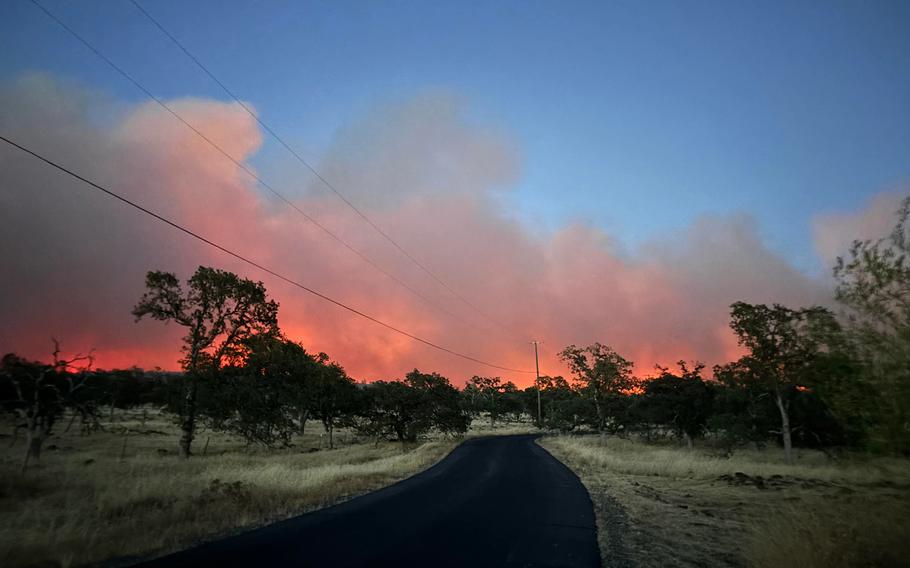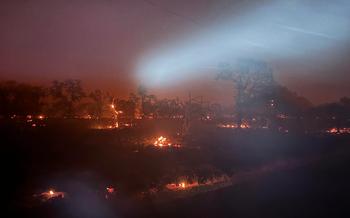
Smoke fills the sky as the Park Fire approaches Chico, Calif., from the east on July 24, 2024. (Mike Waltz)
Mike Waltz was at his office in Chico, Calif., on an afternoon last month when he decided it was time to go. He made calls to his wife Amy and their two sons, Gage and Bennet: The fire was coming, and their home was at risk.
The Park Fire was first reported at 2:52 p.m. on July 24 in Upper Bidwell Park, just east of Chico. The flames took off at a staggering pace, consuming 5,000 acres per hour after first igniting. High winds and dry conditions fueled what would become one of the fastest growing fires in California history. Weeks later, the wildfire is still burning.
By 4 p.m. the Waltz family gathered at their home in the wooded foothills northeast of Chico to prepare for the worst. The mandatory evacuation order went out soon after.
As Amy and their 19- and 22 year-old sons wrangled the family pets and packed two cars with go-bags and supplies, Mike put into action a plan he had developed for just this situation: an extensive fire defense system he created to protect his home from a wildfire’s destructive blaze.
As a California firefighter earlier in life, he had learned to predict fire movement based on wind direction and fuel loads, and had designed an elaborate setup: 32 sprinklers, 300 feet of fire hose and a professional water pump connected to a pool and well - all meant to “develop a defensive line of sprinklers to lay down a humidity bubble.”
If everything on the property was wet, he said, raining embers wouldn’t ignite.
As the sun began to set, Mike had a decision to make: Evacuate with his family, or stay and fight, risking his life to defend their home of the last 20 years.
After a tearful goodbye, Amy and Bennet left with the cars and animals while Mike and Gage stayed behind to face the fast-approaching flames.
For the next couple of hours, Mike and Gage waited wearing flame-resistant gear and helmets as smoke choked the evening air and the sky grew to a terrible shade of red.
At around 10 p.m., Mike said firefighters arrived to warn them flames were fast approaching. Cal Fire had used a bulldozer to cut a line in the vegetation about three houses down to stop the spread of the flames. Mike and Gage were on the wrong side of that line. Still, they stayed.
California fire officials said it’s not uncommon for people to defy evacuation orders.
“We see it more than we like to,” said Edwin Zuniga, a firefighter and Cal Fire public information officer.
“When people decide to stay back, it does hamper those firefighting efforts,” Zuniga added. “... We have to focus on getting people out instead of trying to focus on putting the fire out.”
Minutes after the fire crews left, Mike said the flames reached his property.

The fire moves quickly through the dry brush north of Mike Waltz’s property just east of Chico, California. (Mike Waltz)
As the fire reached the eastern side of their defenses, the sprinklers held. The fast-moving fire continued to spread along the north and south fence lines of his home.
It was the southern hill that posed the most risk. Dry conditions had left tall California gray pine trees ripe for ignition, and they went up fast and hot. Mike described flames towering 150 to 200 feet into the air, showering hot embers down on the property like hail.
But the pair wasn’t trying to address the fire on those trees.
“We’re not going to go out and try and fight the fire,” he said. “We’re going to pull back to the house and turn the hoses on the house.”
The next hour was spent hauling wet fire hose across the property, dousing spot fires and hosing down escaped embers. The two even tried to save the neighbors’ house.
Mike had lost communication with his wife. Having seen the wall of flames during their evacuation, Amy thought for sure her husband and older son were dead.
Hours later, a text finally came through: “we are ok house is saved can’t talk.”
They had saved the family home.
“When the fire kind of passed, you know, the fire department kind of showed back up and it was euphoric,” Mike said. “... We couldn’t believe that we had made it.”
They spent the rest of the night putting out spot fires and monitoring the property line. The next morning’s light revealed another landscape.
“When the sun came up, it was incredible. It was just this barren moonscape and where lush vegetation and trees and all that had been, it’s just gone,” he said. “You know, everything’s gone. And it was really spooky.”
The result of Mike’s efforts can be seen in satellite images taken before and after the Park Fire moved through the community. His home and pool contrast sharply against the ash and char that make up their surroundings, including his neighbor’s home that was lost in the flames.
As Americans continue to move into wildfire hot spots and climate change fuels larger, more frequent fires, at least 1 in 6 Americans now live in areas with significant wildfire risk. The stress, fear and trauma the Waltz family faced during the fire is becoming a more common reality for the typical American homeowner.
The 2015 Humboldt Fire and then the 2018 Camp Fire were wake-up calls for the Waltz family. “Both of those fires kind of got us in a position where we realized we had no defense,” Mike said. “We’re just sitting ducks.”
After the Camp Fire, Mike began assembling his sprinkler system, adding to it each year.
The full list of equipment he used in the fire is as follows: 23 sprinklers along the perimeter of the house, four standing orchard sprinklers placed on the eastern front facing the fire, five homemade roof sprinklers that sat on top of his house and shed, two 300-foot 1½-inch professional fire hoses with accompanying nozzles, a 12,000-gallon pool and a well. All were connected to a “good Honda pump.”
Mike spent multiple springs testing gear, downing trees and cutting back brush. On Father’s Days, Gage and Bennet would run hose drills along the perimeter.
After sharing his story online, people have either responded by calling Mike a hero for protecting his family’s home or an idiot with a garden hose, putting others at risk.
He thinks neither label is wholly true.
“If you don’t have the knowledge of fire or any experience with fire, and if you don’t have substantial ordnance to deal with it, then don’t, because you’ll kill yourself.”
Despite years of experience, regular preparation and thousands of dollars of professional fire equipment, Mike said it was luck that got them through the night.
“I can’t stop saying that we’re lucky,” he said. “And I know we were prepared, but I’m just really thankful that we were able to pull off the plan, and it just worked.”